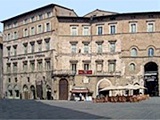

Palazzo Baldeschi Cennini (14th-16th centuries)

A document dated 1361 records his residence here of the famous scholar Baldo degli Ubaldi and his brothers Pietro and Angelo. In 1368, Baldo extended this house after buying the adjacent property that faced the piazza. The Baldeschi arms can be seen above the portal at number 10 Via Baldo. The plaque here, which commemorates Baldo degli Ubaldi, was mounted in 1900, on the 500th anniversary of his death.
Baldo’s descendants continued to buy adjoining properties throughout the 15th century and thereby became the owners of an "island" bounded by what are now Corso Vannucci, Via Baldo, Via dello Struzzo, Via Baglioni and Via Danzetta. Much of this property was rented out as a commercial investment.
Pietro Baldeschi commissioned Ludovico Scalza to work on these properties in 1575. (Ludovico Scalza had already worked on what became Palazzo Baldeschi Bonucci - see below). It was probably at this point that these disparate properties were adapted to form a single residence.
Tiberio I Baldeschi married the Sienese noble woman Irene Piccolomini (see below) in 1586.
The palace takes its current name from the branch of the family formed after the marriage of Tiberio II Baldeschi and Domitilla Cennini in the 17th century. [Date ??]
An inscription on the facade of palace records that Giuseppe Garibaldi addressed the Perugians from the balcony here in 1848.
The upper floors of the palace passed to the Mediocredito dell’ Umbri in 1978. The Fondazione Cassa di Risparmio di Perugia acquired it in 2002 to house its art collection. It sometimes hosts exhibitions: on such occasions, it is possible to admire the collection and splendid interior of the palace.
Windows (1470s)

Frescoes (1856)
Ubaldo Baldeschi commissioned the frescoes on the ceiling of the Sala delle Muse from Mariano Piervittori on the occasion of his marriage to Tecla Balleani; the arms of both families are included in the composition. The main scene records an event at which Braccio Fortebracci sent Matteo degli Ubaldi to Florence as his ambassador to Queen Joanna of Naples in 1420.
Piervittori also executed the frescoes on the ceiling of the adjoining room: it is known as the Sala di Diana e Endimione because the central scene depicts the Goddess Diana looking at the handsome Endymion after Jove has granted her request to send him into eternal sleep so that he would be forever young.
Frescoes (mid 18th century)
These frescoes in the the Sala dei Quattro Elementi are attributed to Paolo Brizi. The central motif depicts a woman flying through the air, carrying flowers to represent the earth. She is accompanied by two putti, one carrying an amphora of water and the other carrying a torch (fire). The scheme includes the arms of Cardinal Federico Baldeschi Colonna (died 1691).
Art from the Palace
Design Attributed to Raphael (1502-4)
This design, which is attributed to Raphael, was used for one of the frescoes by Pintoricchio in the Piccolomini Chapel, Siena. It depicts Cardinal Aeneas Sylvius Piccolomini (later Pope Pius II) in 1452 of the Holy Roman introducing the Emperor Frederick III to his betrothed, Eleanor of Portugal, outside the Porta Camollia of Siena in 1452.
The drawing probably entered the Baldeschi collection in 1586, when Tiberio I Baldeschi married Irene Piccolomini. It was sold at some time after 1905, and is now in the Pierpoint Morgan Library, New York.
Palazzo Baldeschi Bonucci (1560-1626)

An inscription on the facade in Via Baldeschi records that Filippo Baldeschi built it in 1563: this date probably relates to the completion of the first floor of the part of the palace that faces this street, which Filippo used as a law school. After his death in 1567, his heirs commissioned a series of frescoes for the Sala dei Legisti (see below).
It seems that this wing of the palace was complete by 1608. An extension to the rear, which was designed as a separate residence, was still incomplete at that point.
Fabio Danzetta bought the palace in 1623 and completed the work on the extension in 1626. (The division between its two parts is still clearly visible). He sold the palace to Alessandro della Corgna in 1645.
The subsequent history of the building is unclear until the early 18th century, when it passed to the Righetti family. They demolished buildings behind it to open up the view and surrounded the property with metal railings. It was sold to Leopoldo Bonucci, a Perugian industrialist, in 1834. Its lovely garden was much reduced in size when Via Battisti was built behind it in 1902-6.
The palace passed to the charitable Fondazione Orintia Carletti Bonucci in 1968.
Frescoes (late 16th century)
The frescoes of the Sala dei Legisti, which are attributed to Silla Piccinini and Pietro Rancanelli, were commissioned after the death of Filippo Baldeschi in 1567. The scenes include depictions of 19 prominent jurists from the Baldeschi family, including Filippo himself and his most illustrious ancestor, Baldo degli Ubaldi. There is an image of some of the frescoes in the website of the Fondazione Orintia Carletti Bonucci.
Read more:
F. Mancini, “Il Palazzo Baldeschi al Corso: Storia e Architettura” in
F. Mancini (Ed.), “Fondazione Cassa di Risparmio di Perugia: Le Sedi e la Collezione”, (2003) Perugia, pp 45-70
F. Mancini, “Pro Maiori Familie de Ubaldis Amplitudine et Doctorandorum Commoditate: Il Palazzo Cinquecentesco di Via Baldeschi a Perugia” in
C. Frova et al. (Eds), “VI Centenario della Morte di Baldo degli Ubaldi: 1400-2000”, (2005) Perugia, pp 171-92
Return to Monuments of Perugia.
Return to: Walk I (Palazzo Baldeschi Cennini); or
Walk II (Palazzo Baldeschi Bonucci).

